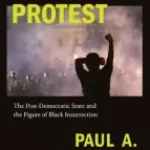Gideon’s Promise: A Public Defender Movement to Transform Criminal Justice
 Author: Jonathan Rapping
Author: Jonathan Rapping
Publisher: Beacon Press, 2020. 238 pages.
Reviewer: Tigran W. Eldred
Jonathan Rapping’s Gideon’s Promise is both a manifesto calling for reform of how the criminal justice system treats people accused of crime and a chronicle of his remarkable work to achieve that result. His central thesis is that the culture of public defense must be revamped so that indigent defendants receive the type of vigorous representation that justice requires. To turn this vision into reality, Rapping describes his efforts to build a movement where public defenders are recruited, trained, and supported in pursuit of a “fiercely client-based ethos” (inside cover). The journey to conceptualize and realize this movement—where public defenders are at the vanguard in the fight to transform the criminal justice system—is at the heart of Gideon’s Promise.
In the Introduction and Chapter 1, Rapping introduces his main themes, which focus on how the process of criminal adjudication systemically undervalues the dignity and worth of those accused of crime and how lawyers for indigent clients often become part of a system that perpetuates injustice. As Rapping describes, the presumption of innocence is largely an illusion for poor people charged with crime, most of whom are treated as part of an assembly line whose lives are reduced to “case files” to be “quickly processed and disposed of” (p. 11). Everyone involved—prosecutors, judges, and defense lawyers—are encouraged to “grease the wheels of the machine” by facilitating the “conveyer belt” toward conviction without much concern for the rights of the accused (pp. 11-13). Examples abound—for instance, Rapping describes lawyers such as Robert Surrency, the contract lawyer in one Georgia county who willingly acceded to the judicial goals of efficiency by pleading almost all his clients guilty, often after spending only minutes conferring with them. Another lawyer in Georgia, Johnny Mostiler, maintained a caseload so large (his contract required him to handle as many as 900 felonies a year) that at times he entered pleas for his clients “at a rate of about 10 to 12 every 45 minutes” (pp. 18–19).
As Rapping explains, the indigent defense crisis is often seen as the result of financial and structural challenges facing defense lawyers, such as excessive caseloads, underfunding of the defense function, and perverse fee structures that disincentivize lawyers from effectively representing their clients. But, as Rapping argues, such impediments to quality defense lawyering are not the cause of these maladies; rather, they are symptoms of an underlying disease, which he diagnoses as a deep-rooted cultural belief that people accused of crimes are “less human” and “not worthy of justice” (p. 19). It is this cultural view, reinforced at almost every turn, that encourages defense lawyers to accept conditions that make effective representation impossible, where indifferent and inadequate representation become commonplace, and where there is little regard for the rights and well-being of people accused of crimes.
Chapter 2 provides more context for this cultural critique, delving into the shifting public perceptions of defense lawyers and their clients. After a discussion of the paramount importance of the constitutional right to counsel, Rapping turns to cultural representations of defense lawyers (especially in movies and TV). Enmeshed in this discussion, not surprisingly, is the issue of race. For instance, as Rapping notes, Gregory Peck’s 1962 portrayal in To Kill a Mockingbird of Atticus Finch, the iconic small-town public defender who heroically represented a black man accused of raping a white woman in 1930s Alabama, “inspired a nation to believe in its system of justice and to revere the role of the lawyer at its foundation” (p. 43). It is “no coincidence,” he notes, that only a year later the Supreme Court handed down its historic decision in Gideon v. Wainwright (1963), which established the right to counsel in state criminal proceedings (p. 43). Yet, as Rapping describes, the inevitable backlash ensued. As gains in civil rights gave way to a “new tough-on-crime era,” cultural representations followed suit: where once the defense was lionized, more recent depictions in TV shows like Law & Order emphasize law enforcement and prosecutorial prowess, while films like My Cousin Vinny reinforce stereotypes of incompetent public defenders (p. 46).
In Chapters 3–6, Rapping explores his journey towards a transformative criminal justice system in more detail. In Chapter 3, we learn that Rapping and his wife, Ilham Askia, decided in 2004 to leave Washington DC, where Rapping worked at the well-funded and client-centered Public Defender Service, to move to Atlanta so that he could become the director of training at Georgia’s newly created state-wide public defender program. There, he created the Georgia Honors Program, which, while short-lived because of funding cuts, became an early template on how to recruit, train and mentor recent law graduates to join a movement of public defenders dedicated to client-centered lawyering. We also learn of the challenges these advocates encountered as they worked in local communities across Georgia, where the prevailing ethos was to accommodate, rather than challenge, indifference to the plight of the accused. As one participant stated after the Honors Program ended, he was “just becoming part of the machine,” a sentiment that Rapping notes “perfectly captured . . . the challenge with public defense”: the need for a supportive community to help passionate lawyers who are “engaged in a constant struggle to resist being shaped by the system” (pp.70-71). Or, to put it bluntly, to “maintain the fuel to rage against the machine” rather than becoming “part of it” (p. 71).
In Chapter 3, Rapping also describes how, in 2006, he left his job in Georgia to take on the challenge of helping to rebuild the public defender office in New Orleans in the aftermath of Hurricane Katrina. There, the problems he encountered were immense: “business as usual” meant not only a “filthy” office of cramped quarters and no online research access, but also a built-in system of oversight that effectively gave judges—whose priority was moving cases quickly rather than ensuring a vigorous defense—control over how public defenders operated (p. 74). Lawyers who refused to abide expedited processing quickly learned to accommodate judicial demands for efficiency or they would be “reassigned, pressured to leave, or—in the rare case of true obstinance—terminated” (p. 75). “Not surprisingly,” Rapping notes, “most public defenders learned to quickly fall in line” (p. 75).
To confront these intolerable conditions, Rapping describes, in Chapter 4, how he became convinced that meaningful and lasting reform in New Orleans and elsewhere would require a cultural change that infuses “dysfunctional public defender culture” with client-centered values (p. 84). Working closely with Askia, Rapping created a new project called the Southern Public Defender Training Center (SPDTC), designed to operate in partnership with local public defender offices to provide three-years of “values-based” training and mentorship to public defenders (p. 86). The centerpiece of the project was the Summer Institute, a two-week intensive training experience (akin to a “boot camp”), where reform-minded faculty trained and mentored lawyers recruited to work in public defender offices in the South (p. 89). The inaugural SPDTC class convened in the summer of 2007 in Birmingham, Alabama, and included 16 lawyers from New Orleans and Atlanta. Rapping goes into detail about the training program, where interactive workshops focused not just on building advocacy skills, but also on creating a sense of community and support. The sessions emphasized learning how to communicate a client’s story and ways to overcome the inevitable obstacles that prevent lawyers from effectively conveying their clients’ narratives. These lessons were reinforced in semiannual meetings, where the recruits would reconvene to reconnect and share their experiences as client-centered advocates. Mentorship also occurred in less formal ways, where Rapping and other mentors helped these defenders to remain committed to their work despite the resistance from a world largely resistant to their efforts.
In Chapters 5–6, we learn about SPDTC’s growth. By 2010, SPDTC had become a formal non-profit organization with partnerships with public defender offices in South Carolina, Mississippi, Tennessee, and elsewhere. Recognizing that the program needed to expand to accommodate its growth, SPDTC added components, including an alumni program to continue to support its graduates, a leadership program to work with partner defender offices, a trainer program to help support and expand its volunteer faculty, and a law school partnership to help recruit future public defenders. In 2013, this comprehensive model was renamed “Gideon’s Promise” (p. 136), which better described its movement of advocates who are working to change the vision of public defense. And as it grew, so did its national reach, with new partnerships with public defense offices in other parts of the country, including Nebraska, South Dakota, Arizona, Pennsylvania, New York, and, in 2014, Maryland—which added over five hundred public defenders to the Gideon’s Promise community (p. 137).
In Chapters 7–8, Rapping turns from discussing recruiting, training, and mentoring of public defenders to the larger role that these lawyers play in shifting the narrative about how those accused of crime are perceived and treated. To counteract the dominant tough-on-crime account that devalues indigent defendants, he argues that reformers need to champion the role of public defenders—not only because they toil daily in courts throughout the nation to create the “necessary friction” to slow down the system’s persistent drive toward convictions, but also because public defenders are essential to telling counter-narratives about those who the state seeks to incarcerate (p. 184). Too often, Rapping laments, public defenders—who individually and collectively champion the humanity of their clients—are overlooked in discussions about how to address the injustices of mass incarceration. In his final chapter, Rapping ends where he began, by making plain his argument that deep change cannot depend on technical fixes to a broken system; rather, it will occur only when there is a fundamental cultural shift in the narrative about those caught in the net of incarceration. Public defenders, Rapping concludes, must be at the forefront of this movement for change.
Ultimately, there is little to dispute in Rapping’s fundamental thesis. Indeed, as we emerge again from a recent political campaign cycle where fear of crime has been a dominant theme, his call for a cultural transformation rings true. If there is a question to be raised, it is whether the success of this reformist agenda can be quantified—that is, even with the remarkable work done by Gideon’s Promise since its birth, has the dominant culture of indifference and neglect been meaningfully altered? Here too, there are compelling responses. To begin with, Rapping notes that preliminary data collected suggests that Gideon’s Promise lawyers get “better outcomes” on many objective measures, such as the frequency that clients plead guilty or are incarcerated, than other lawyers (p. 200). Further, because such traditional outcomes do not fully measure the value of client-centered advocacy, Gideon’s Promise has worked with experts in social-impact analytics to develop a model to assess its qualitative impact, such as the degree to which lawyers “embrace . . . client-centered values” and how much “clients associate the quality of justice with client-centered lawyers” (p. 204). Similar measures can help to assess the conduct of others in the system, including judges and prosecutors. To these points I would add one more: the urgent work of Gideon’s Promise should be championed because justice requires it, irrespective of whether each step along the way can be quantified by some measurable matrix. As Rapping concludes, public defenders are “the conscience of the criminal justice system” and, as such, “remind us of the ideals at the heart of American democracy and to ensure we do not lose sight of the human beings the system is there to serve” (p. 207).
Tigran W. Eldred is a Professor of Law at New England Law School in Boston MA.


